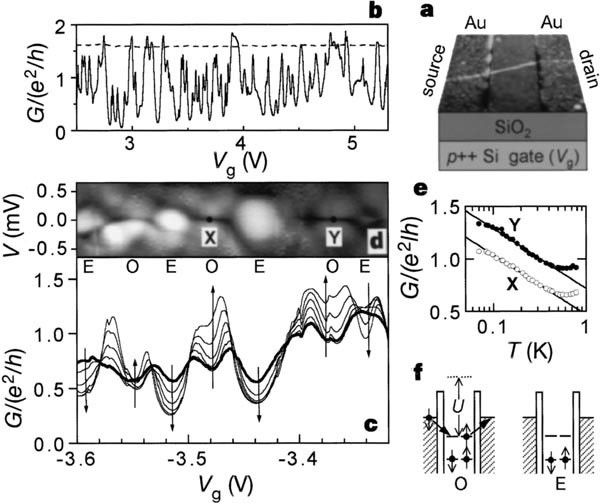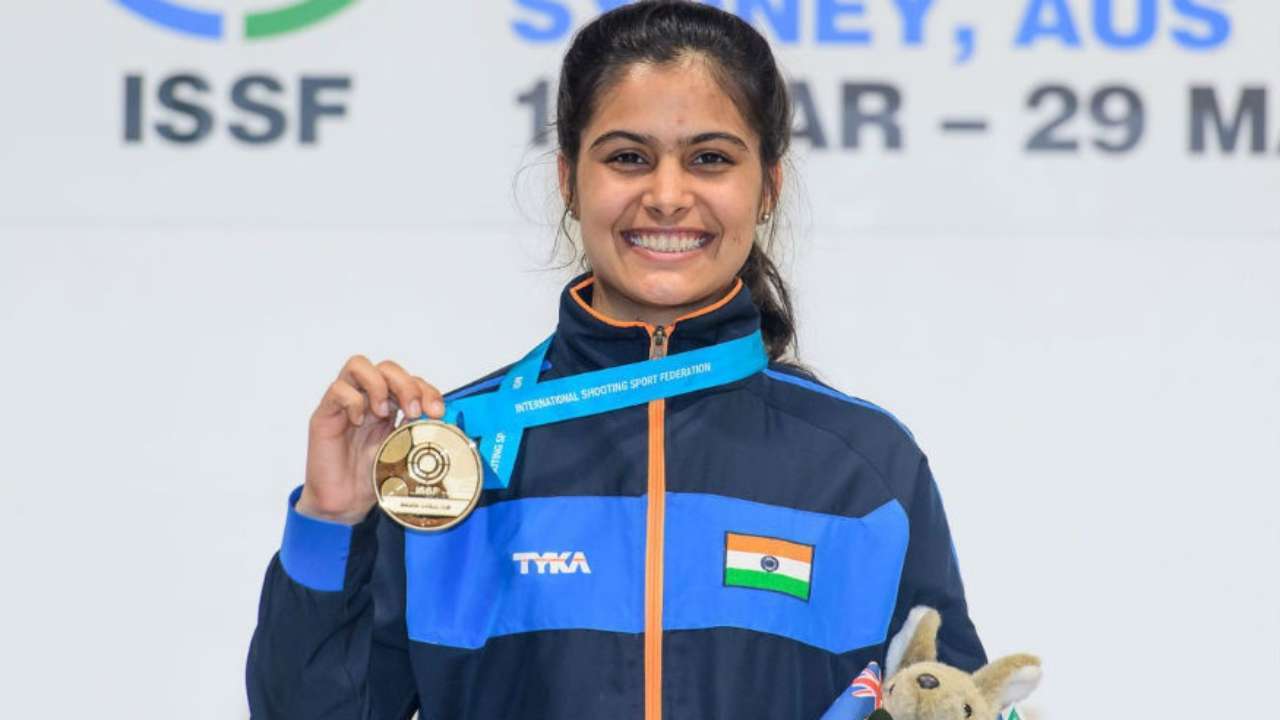
- Select a language for the TTS:
- UK English Female
- UK English Male
- US English Female
- US English Male
- Australian Female
- Australian Male
- Language selected: (auto detect) - EN
Play all audios:
ABSTRACT The connection of electrical leads to wire-like molecules is a logical step in the development of molecular electronics, but also allows studies of fundamental physics. For example,
metallic carbon nanotubes1 are quantum wires that have been found to act as one-dimensional quantum dots2,3, Luttinger liquids4,5, proximity-induced superconductors6,7 and ballistic8 and
diffusive9 one-dimensional metals. Here we report that electrically contacted single-walled carbon nanotubes can serve as powerful probes of Kondo physics, demonstrating the universality of
the Kondo effect. Arising in the prototypical case from the interaction between a localized impurity magnetic moment and delocalized electrons in a metallic host, the Kondo effect has been
used to explain10 enhanced low-temperature scattering from magnetic impurities in metals, and also occurs in transport through semiconductor quantum dots11,12,13,14,15,16,17,18. The far
greater tunability of dots (in our case, nanotubes) compared with atomic impurities renders new classes of Kondo-like effects19,20 accessible. Our nanotube devices differ from previous
systems in which Kondo effects have been observed, in that they are one-dimensional quantum dots with three-dimensional metal (gold) reservoirs. This allows us to observe Kondo resonances
for very large electron numbers (_N_) in the dot, and approaching the unitary limit (where the transmission reaches its maximum possible value). Moreover, we detect a previously unobserved
Kondo effect, occurring for even values of _N_ in a magnetic field. Access through your institution Buy or subscribe This is a preview of subscription content, access via your institution
ACCESS OPTIONS Access through your institution Subscribe to this journal Receive 51 print issues and online access $199.00 per year only $3.90 per issue Learn more Buy this article *
Purchase on SpringerLink * Instant access to full article PDF Buy now Prices may be subject to local taxes which are calculated during checkout ADDITIONAL ACCESS OPTIONS: * Log in * Learn
about institutional subscriptions * Read our FAQs * Contact customer support SIMILAR CONTENT BEING VIEWED BY OTHERS INFERRING THE ENERGY SENSITIVITY AND BAND GAP OF ELECTRONIC TRANSPORT IN A
NETWORK OF CARBON NANOTUBES Article Open access 08 February 2022 NANO-ASSEMBLED OPEN QUANTUM DOT NANOTUBE DEVICES Article Open access 05 January 2024 A TWO-SITE KITAEV CHAIN IN A
TWO-DIMENSIONAL ELECTRON GAS Article 12 June 2024 REFERENCES * Dekker, C. Carbon nanotubes as molecular quantum wires. _Phys. Today_ 52, 22–28 (1999). Article ADS CAS Google Scholar *
Tans, S. et al. Individual single-walled carbon nanotubes as quantum wires. _ Nature_ 386, 474–477 ( 1997). Article ADS CAS Google Scholar * Bockrath, M. _ et al_. Single-electron
transport in ropes of carbon nanotubes. _ Science_ 275, 1922–1925 ( 1997). Article CAS Google Scholar * Bockrath, M. _ et al_. Luttinger-liquid behaviour in carbon nanotubes. _ Nature_
397, 598–601 ( 1999). Article ADS CAS Google Scholar * Yao, Z., Postma, H. W. C., Balents, L. & Dekker, C. Carbon nanotube intramolecular junctions. _Nature_ 402 , 273–276 (1999).
Article ADS CAS Google Scholar * Kasumov, A. Y. _ et al_. Supercurrents through single-walled carbon nanotubes. _ Science_ 284, 1508–1511 ( 1999). Article ADS CAS Google Scholar *
Morpurgo, A. F., Kong, J., Marcus, C. & Dai, H. Gate-controlled superconducting proximity effect in carbon nanotubes. _Science_ 286, 263–265 (1999). Article CAS Google Scholar *
Frank, S., Poncharal, S. P., Wang, Z. L. & de Heer, W. A. Carbon nanotube quantum resistors. _Science_ 280, 1744–1746 (1998). Article ADS CAS Google Scholar * Bachtold, A. _ et al_.
Aharonov–Bohm oscillations in carbon nanotubes. _ Nature_ 397, 673–675 ( 1999). Article ADS CAS Google Scholar * Hewson, A. C. _ The Kondo Problem to Heavy Fermions_ (Cambridge Univ.
Press, Cambridge, 1993). Book Google Scholar * Glazman, L. I. & Raikh, M. E. Resonant Kondo transparency of a barrier with quasilocal impurity states. _JETP Lett._ 47, 452–455 ( 1988).
ADS Google Scholar * Ng, T. K. & Lee, P. A. On-site Coulomb repulsion and resonant tunneling. _Phys. Rev. Lett._ 61, 1768– 1771 (1988). Article ADS CAS Google Scholar * Meir, Y.,
Wingreen, N. S. & Lee, P. A. Low-temperature transport through a quantum dot: the Anderson model out of equilibrium. _Phys. Rev. Lett._ 70, 2601–2604 (1993). Article ADS CAS Google
Scholar * Goldhaber-Gordon, D. _ et al_. Kondo effect in a single-electron transistor. _ Nature_ 391, 156–159 ( 1998). Article ADS CAS Google Scholar * Goldhaber-Gordon, D. _ et al_.
From the Kondo regime to the mixed-valence regime in a single-electron transistor. _Phys. Rev. Lett._ 81, 5225– 5228 (1998). Article ADS CAS Google Scholar * Cronenwett, S. M.,
Oosterkamp, T. H. & Kouwenhoven, L. P. A tuneable Kondo effect in quantum dots. _ Science_ 281, 540–544 ( 1998). Article ADS CAS Google Scholar * Schmid, J., Weis, J., Eberl, K.
& v. Klirtzing, K. A quantum dot in the limit of strong coupling to reservoirs. _Physica B_ 256–258, 182–185 ( 1998). Article ADS Google Scholar * Simmel, F., Blick, R. H., Kotthaus,
J. P., Wegscheider, W. & Bichler, M. Anomalous Kondo effect in a quantum dot at nonzero bias. _Phys. Rev. Lett._ 83, 804–807 (1999). Article ADS CAS Google Scholar * Sasaki, S. _ et
al_. A novel Kondo effect in an integer-spin quantum dot. _ Nature_ 405, 764–767 ( 2000). Article ADS CAS Google Scholar * Pustilnik, M., Avishai, Y. & Kikoin, K. Quantum dots with
even number of electrons: Kondo effect in a finite magnetic field. _Phys. Rev. Lett._ 84, 1756–1759 (2000). Article ADS CAS Google Scholar * Nygård, J., Cobden, D. H., Bockrath, M.,
McEuen, P. L. & Lindelof, P. E. Electrical transport measurements on single-walled carbon nanotubes. _Appl. Phys. A_ 69 , 297–304 (1999). Article ADS Google Scholar * Soh, H. T. _ et
al_. Integrated nanotube circuits: Controlled growth and ohmic contacting of single-walled carbon nanotubes. _Appl. Phys. Lett. _ 75, 627–629 ( 1999). Article ADS CAS Google Scholar *
Glazman, L. I. Single electron tunneling. _J. Low Temp. Phys._ 118, 247–269 (2000). Article ADS CAS Google Scholar * Tans, S., Devoret, M. H., Groeneveld, R. J. A. & Dekker, C.
Electron–electron correlations in carbon nanotubes. _Nature _ 394, 761–764 ( 1998). Article ADS CAS Google Scholar * Cobden, D. H., Bockrath, M., McEuen, P. L., Rinzler, A. G. &
Smalley, R. E. Spin splitting and even-odd effects in carbon nanotubes. _Phys. Rev. Lett._ 81, 681–684 (1998). Article ADS CAS Google Scholar * Thess, A. _et al_. Crystalline ropes of
metallic carbon nanotubes. _Science _ 273, 483–487 ( 1996). Article ADS CAS Google Scholar Download references ACKNOWLEDGEMENTS We thank A. Rinzler and R. Smalley for supplying the
nanotubes, K. G. Rasmussen, M. M. Andreasen, A. E. Hansen and A. Kristensen for experimental assistance, and M. Pustilnik, N. Wingreen, L. P. Kouwenhoven, N. d'Ambrumenil, P. R. Poulsen
and P. L. McEuen for helpful discussions. AUTHOR INFORMATION AUTHORS AND AFFILIATIONS * Ørsted Laboratory, Niels Bohr Institute, Universitetsparken 5, Copenhagen, DK-2100 , Denmark Jesper
Nygård & Poul Erik Lindelof * Department of Physics, University of Warwick, Coventry, CV4 7AL, UK David Henry Cobden Authors * Jesper Nygård View author publications You can also search
for this author inPubMed Google Scholar * David Henry Cobden View author publications You can also search for this author inPubMed Google Scholar * Poul Erik Lindelof View author
publications You can also search for this author inPubMed Google Scholar CORRESPONDING AUTHOR Correspondence to David Henry Cobden. RIGHTS AND PERMISSIONS Reprints and permissions ABOUT THIS
ARTICLE CITE THIS ARTICLE Nygård, J., Cobden, D. & Lindelof, P. Kondo physics in carbon nanotubes. _Nature_ 408, 342–346 (2000). https://doi.org/10.1038/35042545 Download citation *
Received: 30 May 2000 * Accepted: 03 October 2000 * Issue Date: 16 November 2000 * DOI: https://doi.org/10.1038/35042545 SHARE THIS ARTICLE Anyone you share the following link with will be
able to read this content: Get shareable link Sorry, a shareable link is not currently available for this article. Copy to clipboard Provided by the Springer Nature SharedIt content-sharing
initiative









